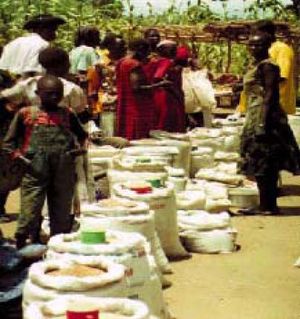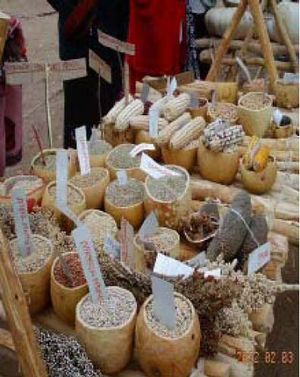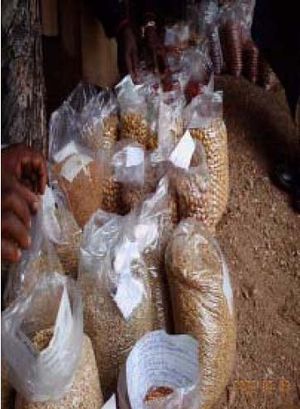
SEED FAIRS[edit | edit source]
Introduction[edit | edit source]
Seed supply mechanism for communal farmers have increasingly become unreliable and unpredictable. Frequently farmers cannot obtain their seed on time as either the seed is not readily available on the local market or available varieties are not suitable for local conditions. Crop failure is common due to late planting directly linked to late availability of seed and the poor adaptability of these available varieties to local agro-ecological and socio-economic conditions. Recurrent droughts have also resulted in local seed stocks being exhausted because seed is being converted into food and the stocks are not being replenished year in year out due to crop failure.
In Tanzania for example commercial producers of certified seed are not available in remote districts and local business people are reluctant to stock seed because demand is uncertain. The varieties developed by the official seed companies are often promoted by national and local extension agencies although they have been developed for higher potential areas.
The long-term food security for communal farmers has been worsened by ad-hoc welfare interventions by both Governments and Non-Governmental Organizations (NGOs). Food aid packages have been expanded to include food components to cater for short-term and immediate needs and seed packs for agricultural recovery purposes, which is often sourced from outside the areas they are distributed and at worst from outside the countries of their distribution.
These welfare interventions have managed to avert famines in the short term but have impacted negatively on crop diversity and long-term food security.
In response to these institutional shortcomings in responding to community seed requirements and in an effort to build local capacity to meet seed needs, there has been a growing emphasis in community driven seed supply mechanisms. However whilst this shift did espouse appreciation and the importance of local capacities such as farmers' own knowledge, they have continued to be strongly based on preconceived ideas on which varieties were best for farmers.
Seed fairs[edit | edit source]
The main purpose of any fair is to provide a specialised market place where not only traders display their products and buyers come to purchase, but it is specialised since it normally deals in one sector, examples are Building Fairs and Agricultural Fairs. A seed fair is as the name suggests, a fair specialising in seed and is normally organised at a local or village level.
The objectives of Seed Fairs include:
- Creating awareness amongst farmers, researchers, extensionists and district planners of additional alternative seeds and planting material from research station and about seed from farmers' own sources.
- Enabling local, extensionists and farmer seed experts who do not normally meet to do so and exchange knowledge and experiences on the old and new crops that they grow.
- To create working contacts between farmers, extensionists and researchers which will continue to exist and develop independent of outside facilitators.
- Create opportunities for seed exchanges or arrange future exchanges.
- Enable disaster affected farmers to access crops/varieties in quantites of their choice.
- Instil confidence among farmers through a healthy and productive competition.
- Create market linkages.
- Create social interaction.
Benefits from seed fairs[edit | edit source]
Some of the benefits of a seed fair are:
- Promoting seed based to local conditions as farmers exchange and sell seed grown and produced locally.
- Help insure farmers against climatic uncertainties by availing different crop types and varieties.
- Seed fairs help build the local seed distribution system as opposed to 'ad-hoc' welfare interventions.
- Farmers may find out innovations on the market whilst seed producers find out farmer needs, tastes and concerns.
- Market linkages can also be pursued which may promote agro-processing and value addition.
- Creates a discussion forum for farmers on the quality, usefulness and price of the seed.
- Seed companies may gather valuable information to improve the quality of their seed.
Conducting a seed fair[edit | edit source]
• Preparation
The seed fair is organised at a local level either village or ward and all preparations should be coordinated at the local level. The most significant of these preparations are taking stock of the available seed, determining and agreeing on the judging criteria, selecting judges and judges pre-fair meeting, sharing determined judging criteria with exhibitors, food arrangements, selecting a suitable venue and stand preparation.
The venue should be easily accessible and desirably centrally located. The date and timing of the fair takes into consideration local beliefs and events. It should also be help appropriately in accordance with the cropping calendar, which normally should be after harvesting and before the rains.
• Determining the judging criteria
The judging criteria may include the extent of crop and variety diversity, crop (produce) and seed quality, quality of presentation, exhibitor's knowledge of displayed crops and varieties, crop and variety origin, variety suitability to local conditions, history of performance under local or similar conditions and the display itself.
• Selecting Judges
Judges are selected from amongst the community itself with representation from all the participating groups. To increase impartiality representatives or extension workers from local farmer support and extension organizations may also support the judging team.
- Competition Participants
The community, based on local dynamics, determines who can exhibit -individuals, farmer groups or villages. If the seed fair is being held at village level then individual or group exhibitions are recommended, however if it is a ward seed fair, the village exhibitions should suffice due to space constraints and to speed up the judging process.
Figure 1. Vilage exhibitions at a Seed Fair in Gwanda District, Zimbabwe. The seed can be displayed in transparent bags for easy viewing.


• Seed Exchanges
The main purpose of a seed fair is promote local seed exchanges, it is however important to keep a track of the exchanges to be able to monitor how much seed is exchanged locally and with externals through either batter or cash purchases. Monitoring will help identify the origin of all the seed exchanged and will help maintain linkages and farmer seed networks.
In addition to the seed that is on display, exhibitors may bring larger quantities of the same varieties to the samples for sale on a cash basis or for exchanges with other farmers from within or without the ward. All sales or exchanges should be recorded for monitoring purposes.
• Seed Fair Prizes
Seed fair prizes can either be cash or farm inputs such as seed packs, implements such as ploughs and wheelbarrows. These can be sourced through community contributions, cash and material donations from NGOs and local business people.
• Stakeholder Participation
The community invites stakeholders at their own discretion and these invitations are usually dependent on the invitee's possible input to the seed security of the community. Stakeholders whose participation may add value include local government structures (local authorities – councils and administrators), extension support agencies both government and private sector, research institutions, development and relief agencies, funding agencies, farmer groups, individual farmers from both within and outside the locality.
Seed voucher system[edit | edit source]
In some areas/countries a seed voucher system has been linked to seed fairs and this has been used mainly in emergency or relief situations for agricultural recovery purposes. Instead of giving out free seed, farmers are given vouchers with a specific value, which they exchange for seed at a seed fair. The vouchers are later redeemed for cash at the end of the fair. Vouchers can be distributed in a specialised relief system to the needy or most vulnerable as identified by the community itself or they can be open to everyone where the aid is open.
Figure 2 and 3: Seed traders display their seed and farmers purchase using redeemable vouchers.


Different crop types and seed varieties can be purchased at the fair and individual vendors who may include farmers, small-scale traders, large seed companies may offer either local traditional varieties or modern certified varieties. Instead of providing seed for recovery purposes, farmers are able to choose the variety and quality of seed they want. The seed voucher system has been introduced by such organizations as the Catholic Relief Services (CRS) and Save the Children in Tanzania, Kenya, Uganda, Sudan, Mozambique and Zimbabwe.
Advantages of the seed voucher system[edit | edit source]
In addition to the advantages of a conventional seed fair mentioned earlier there are other advantages of a seed voucher system:
- In addition to supporting the affected communities with seed, a seed voucher system injects emergency funds directly into the affected communities rather than at the central level or importing seed.
- Emergency funds are invested directly in disaster areas and this will revitalise local businesses and the local economy.
- The system promotes both certified hybrid seed and locally produced seed.
- The participation of commercial seed producers introduces new varieties, which increase the region's genetic diversity.
- Farmers purchase seed of their preferred varieties.
- Farmers use their own judgement to judge the seed quality.
- The vouchers are cost effective, simple to implement, monitor and evaluate.

Seed vouchers and seed multiplication[edit | edit source]
The seed voucher system can also be used with seed multiplication where seed is provided to a few farmers identified by the community and these will be responsible for multiplying that seed and selling the seed they produce to voucher holders in the community.
The seed produced will be sold or exchanged for vouchers at a seed fair or a seed fair can be organised to link the seed multipliers with farmers who require seed. After the fair the selling will be conducted on an individual basis and the vouchers are later redeemed for cash.
The seed voucher system is used mainly with such crops as sweet potatoes and Open Pollinated Varieties of maize, sorghum and pearl millet. This is necessary to maintain genequality.
Seed fair experiences[edit | edit source]
A number of organizations in the sub-Saharan region have been involved with seed fairs may provide valuable experiences. Some of the organizations include:
Practical Action (Southern Africa)
Practical Action (East Africa)
Catholic Relief Services
International Crops Research Institute for the Semi-Arid Tropics (ICRISAT)
COMMUTECH
Department of Agriculture Research and Extension (AREX)(Zimbabwe)
Save the Children
Farmer Associations for Chiefs and Headman Investment Groups (FACHIG)
World Vision
CARE International
Information resources[edit | edit source]
Reducing Vulnerability Programme
Practical Action Southern Africa
P. O. Box 1744
Harare
Zimbabwe Tel: +263 4 77661-3/776107
Fax: +263 4 788157
E-mail: absolomm@practicalaction.org.zw
Website: http://www.practicalaction.org
Catholic Relief Services (East Africa)
P. O. Box 49675
Nairobi
Kenya
Website: http://www.catholicrelief.org
International Crop Research institute for the Semi Arid Tropics (ICRISAT)
P. O. Box 39063
Nairobi
Kenya
Website: https://www.icrisat.org/
CRS; ICRISAT and ODI (2002): Seed Vouchers and Fairs: A manual for seed based agricultural recovery after disaster in Africa; Kenya
ICRISAT and INIA (2002): Improving the efficiency of Seed Distribution: Organising Seed Fairs in Emergency Situations; Mozambique.